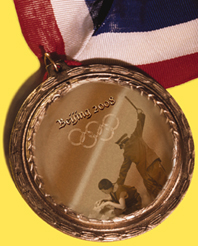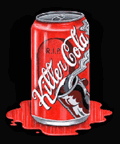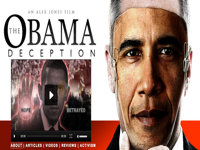Posts Tagged ‘naomi-klein’
Naomi Klein’s Latest Column
Obama’s Chicago Boys
by Naomi Klein, June 13, 2008
Barack Obama waited just three days after Hillary Clinton pulled out of the race to declare, on CNBC, “Look. I am a pro-growth, free-market guy. I love the market.”
Demonstrating that this is no mere spring fling, he has appointed 37-year-old Jason Furman to head his economic policy team. Furman is one of Wal-Mart’s most prominent defenders, anointing the company a “progressive success story.” On the campaign trail, Obama blasted Clinton for sitting on the Wal-Mart board and pledged, “I won’t shop there.” For Furman, however, it’s Wal-Mart’s critics who are the real threat: the “efforts to get Wal-Mart to raise its wages and benefits” are creating “collateral damage” that is “way too enormous and damaging to working people and the economy more broadly for me to sit by idly and sing ‘Kum-Ba-Ya’ in the interests of progressive harmony.”
Obama’s love of markets and his desire for “change” are not inherently incompatible. “The market has gotten out of balance,” he says, and it most certainly has. Many trace this profound imbalance back to the ideas of Milton Friedman, who launched a counter-revolution against the New Deal from his perch at the University of Chicago economics department. And here there are more problems, because Obama—who taught law at the University of Chicago for a decade—is thoroughly embedded in the mindset known as the Chicago School.
He chose as his chief economic adviser Austan Goolsbee, a University of Chicago economist on the left side of a spectrum that stops at the center-right. Goolsbee, unlike his more Friedmanite colleagues, sees inequality as a problem. His primary solution, however, is more education—a line you can also get from Alan Greenspan. In their hometown, Goolsbee has been eager to link Obama to the Chicago School. “If you look at his platform, at his advisers, at his temperament, the guy’s got a healthy respect for markets,” he told Chicago magazine. “It’s in the ethos of the , which is something different from saying he is laissez-faire.”
Another of Obama’s Chicago fans is 39-year-old billionaire Kenneth Griffin, CEO of the hedge fund Citadel Investment Group. Griffin, who gave the maximum allowable donation to Obama, is something of a poster boy for an unbalanced economy. He got married at Versailles and had the after-party at Marie Antoinette’s vacation spot (Cirque du Soleil performed)—and he is one of the staunchest opponents of closing the hedge fund tax loophole. While Obama talks about toughening trade rules with China, Griffin has been bending the few barriers that do exist. Despite sanctions prohibiting the sale of police equipment to China, Citadel has been pouring money into controversial China-based security companies that are putting the local population under unprecedented levels of surveillance.
Now is the time to worry about Obama’s Chicago Boys and their commitment to fending off serious attempts at regulation. It was in the two and a half months between winning the 1992 election and being sworn into office that Bill Clinton did a U-turn on the economy. He had campaigned promising to revise NAFTA, adding labor and environmental provisions and to invest in social programs. But two weeks before his inauguration, he met with then Goldman Sachs chief Robert Rubin, who convinced him of the urgency of embracing austerity and more liberalization. Rubin told PBS, “President Clinton actually made the decision before he stepped into the Oval Office, during the transition, on what was a dramatic change in economic policy.”
Furman, a leading disciple of Rubin, was chosen to head the Brookings Institution’s Hamilton Project, the think tank Rubin helped found to argue for reforming, rather than abandoning, the free trade agenda. Add to that Goolsbee’s February meeting with Canadian consulate officials, who left with the distinct impression that they had been instructed not to take Obama’s anti-NAFTA campaigning seriously, and there is every reason for concern about a replay of 1993.
The irony is that there is absolutely no reason for this backsliding. The movement launched by Friedman, introduced by Ronald Reagan and entrenched under Clinton, faces a profound legitimacy crisis around the world. Nowhere is this more evident than at the University of Chicago itself. In mid-May, when university president Robert Zimmer announced the creation of a $200 million Milton Friedman Institute, an economic research center devoted to continuing and augmenting the Friedman legacy, a controversy erupted. More than 100 faculty members signed a letter of protest. “The effects of the neoliberal global order that has been put in place in recent decades, strongly buttressed by the Chicago School of Economics, have by no means been unequivocally positive,” the letter states. “Many would argue that they have been negative for much of the world’s population.”
When Friedman died in 2006, such bold critiques of his legacy were largely absent. The adoring memorials spoke only of grand achievement, with one of the more prominent appreciations appearing in the New York Times—written by Austan Goolsbee. Yet now, just two years later, Friedman’s name is seen as a liability even at his own alma mater. So why has Obama chosen this moment, when all illusions of a consensus have dropped away, to go Chicago retro?
The news is not all bad. Furman claims he will be drawing on the expertise of two Keynesian economists: Jared Bernstein of the Economic Policy Institute and James Galbraith, son of Friedman’s nemesis John Kenneth Galbraith. Our “current economic crisis,” Obama recently said, did not come from nowhere. It is “the logical conclusion of a tired and misguided philosophy that has dominated Washington for far too long.”
True enough. But before Obama can purge Washington of the scourge of Friedmanism, he has some ideological housecleaning of his own to do.
This column was first published in The Nation.
 free-market, economics, corporation, politics, news, life, usa, naomi-klein
free-market, economics, corporation, politics, news, life, usa, naomi-klein
READ PRECEDENT ARTICLES:
CIA’s interrogation methods: the top secret tortures pt. I/V
CIA’s interrogation methods: the top secret tortures pt. II/V
.
FROM THE KUBARK MANUAL (1963)
This manual cannot teach anyone how to be, or become, a good interrogator. At best it can help readers to avoid the characteristic mistakes of poor interrogators.
Its purpose is to provide guidelines for KUBARK interrogation, and particularly the counterintelligence interrogation of resistant sources. Designed as an aid for interrogators and others immediately concerned, it is based largely upon the published results of extensive research, including scientific inquiries conducted by specialists in closely related subjects.
Kassandra’s note. Yes: in the world there are criminal scientists who tortured people like you and me in order to obtain this kind of informations. English and american citizens has been preferred as victims.
There is nothing mysterious about interrogation. It consists of no more than obtaining needed information through responses to questions. As is true of all craftsmen, some interrogators are more able than others; and some of their superiority may be innate. But sound interrogation nevertheless rests upon a knowledge of the subject matter and on certain broad principles, chiefly psychological, which are not hard to understand. The success of good interrogators depends in large measure upon their use, conscious or not, of these principles and of processes and techniques deriving from them.
Kassandra’s note. Of course: it’s important the torture method.
Knowledge of subject matter and of the basic principles will not of itself create a successful interrogation, but it will make possible the avoidance of mistakes that are characteristic of poor interrogation. The purpose, then, is not to teach the reader how to be a good interrogator but rather to tell him what he must learn in order to become a good interrogator.
The interrogation of a resistant source who is a staff or agent member of an Orbit intelligence or security service or of a clandestine Communist organization
Kassandra’s note. Communists, spies, terrorists… anyone else? Why did they try those methods on people like Gail Kastner, a victim of covert C.I.A. experiments in interrogation techniques that were carried out by the scientist Ewen Cameron in the 1950s.
His idea was to use electroshock therapy to break down patients. Once “complete depatterning” had been achieved, the patients could be reprogrammed. But after breaking down his “patients,” Cameron was never able to build them back up again. (Joseph E. Stiglitz, a university professor at Columbia, was awarded the Nobel in economic science in 2001. His latest book is “Making Globalization Work.”, International Herald Tribune, Source)
is one of the most exacting of professional tasks. Usually the odds still favor the interrogator, but they are sharply cut by the training, experience, patience and toughness of the interrogatee. In such circumstances the interrogator needs all the help that he can get.
And a principal source of aid today is scientific findings. The intelligence service which is able to bring pertinent, modern knowledge to bear upon its problems enjoys huge advantages over a service which conducts its clandestine business in eighteenth century fashion. It is true that American psychologists have devoted somewhat more attention to Communist interrogation techniques, particularly “brainwashing”, than to U. S. practices.
Kassandra’s note. Wonderful: they admit it!
Yet they have conducted scientific inquiries into many subjects that are closely related to interrogation: the effects of debility and isolation, the polygraph, reactions to pain and fear, hypnosis and heightened suggestibility, narcosis, etc. This work is of sufficient importance and relevance that it is no longer possible to discuss interrogation significantly without reference to the psychological research conducted in the past decade. For this reason a major purpose of this study is to focus relevant scientific findings upon CI interrogation. Every effort has been made to report and interpret these findings in our own language, in place of the terminology employed by the psychologists.
This study is by no means confined to a resume and interpretation of psychological findings. The approach of the psychologists is customarily manipulative; that is, they suggest methods of imposing controls or alterations upon the interrogatee from the outside. Except within the Communist frame of reference, they have paid less attention to the creation of internal controls — i.e., conversion of the source, so that voluntary cooperation results. Moral considerations aside, the imposition of external techniques of manipulating people carries with it the grave risk of later lawsuits, adverse publicity, or other attempts to strike back.
Kassandra’s note. We have no words to comment this.
 CIA, honduras, Human-Rights, life, news, politics, shock, top-secret, tortures, usa, naomi-klein
CIA, honduras, Human-Rights, life, news, politics, shock, top-secret, tortures, usa, naomi-klein
Source: naomiklein.org
“When I finished The Shock Doctrine, I sent it to Alfonso Cuarón because I adore his films and felt that the future he created for Children of Men was very close to the present I was seeing in disaster zones. I was hoping he would send me a quote for the book jacket and instead he pulled together this amazing team of artists — including Jonás Cuarón who directed and edited — to make The Shock Doctrine short film. It was one of those blessed projects where everything felt fated.” – Naomi Klein
Watch the short film in Spanish. Quicktime high resolution or Quicktime medium resolution.
See the short film in Italian. Windows or Quicktime: High resolution or Medium resolution.
Read an interview between Naomi Klein, Alfonso Cuarón and Jonás Cuarón about the making of The Shock Doctrine short film.
Read the list of fast facts, shocks and their aftermath from The Shock Doctrine Short Film.
.
Naomi Klein – The Shock Doctrine
Part 1 of 6
Part 2 of 6
Part 3 of 6
Part 4 of 6
Part 5 of 6
Part 6 of 6
 naomi-klein, conspiracies, economy, corporation, politics, news, life, environment, manipulation, disinformation
naomi-klein, conspiracies, economy, corporation, politics, news, life, environment, manipulation, disinformation



 E-mail Subscribe
E-mail Subscribe


































